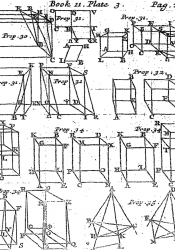Euclid's Elements (300 BC)
With its five postulates and thirteen books, Euclid’s Elements (written circa 300 BCE) set the precedent for the way humans do mathematics, establishing a norm of clearly stated assumptions and carefully delineated logic when giving a proof. As such, Elements was the seminal text for geometry in the plane well until the nineteenth century when new geometric paradigms supplanted Euclidean geometry. The revived interest in the intellectual achievements of the Greeks during the Renaissance certainly included a fascination with Euclidean geometry, which provided the mathematical underpinnings for Renaissance painters to develop perspective, a technique used to represent a three-dimensional image on a flat surface. While perspective was an important feature in da Vinci’s paintings, it was also a crucial aspect in his geometric sketches in which he was tasked with finding the best way to depict complicated three-dimensional geometric figures in the plane. Lastly, Elements established a norm of codifying mathematical knowledge into a single text, a norm that Luca Pacioli (the geometer for whom da Vinci created geometric sketches) strived to uphold with his comprehensive mathematical summaries such as De Divina Proportione and Summa de arithmetica, geometria, proportioni et proportionalita (the first of which necessitated da Vinci’s artistic abilities for illustrations).
Sources
Kline, Morris. “Projective Geometry.” Scientific American, vol. 192, no. 1, 1955, pp. 80–86., doi:10.1038/scientificamerican0155-80.
“Luca Pacioli.” Luca Pacioli (1445-1517), School of Mathematics and Statistics, University of St. Andrews, Scotland, www-history.mcs.st-and.ac.uk/Biographies/Pacioli.html.
Shearer, Rhonda Roland. “Chaos Theory and Fractal Geometry: Their Potential Impact on the Future of Art.” Leonardo, vol. 25, no. 2, 1992, pp. 143–152., doi:10.2307/1575702.
The image source is Wikimedia Commons, and it is in the public domain in the United States because it was published (or registered with the U.S. Copyright Office) before January 1, 1924.

